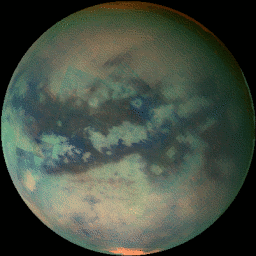Explanation: Titan is one of the strangest places in our Solar System. The only moon known with thick clouds, this unusual satellite of Saturn shows evidence of evaporating lakes created by methane rain. The clouds that make Titan featureless in visible light have now been imaged several times in infrared light by the robot Cassini spacecraft currently orbiting Saturn. These images have been compiled into the above time-lapse movie. Like Earth's Moon, Titan always shows the same face toward its central planet. It therefore takes Titan about 16 days to complete one rotation. Titan has numerous areas of light terrain with some large areas of dark terrain visible near the equator. Small areas of brightest terrain might arise from ice-volcanoes and have a high amount of reflective frozen water-ice. Titan's surface was imaged for the first time early last year by the Huygens probe, which survived for three hours on a cold and sandy dark region.
1999 2000 2001 2002 2003 2004 2005 2006 2007 2008 2009 2010 2011 2012 2013 2014 2015 2016 2017 2018 2019 2020 2021 2022 2023 2024 2025 |
Yanvar' Fevral' Mart Aprel' Mai Iyun' Iyul' Avgust Sentyabr' Oktyabr' Noyabr' Dekabr' |
NASA Web Site Statements, Warnings, and Disclaimers
NASA Official: Jay Norris. Specific rights apply.
A service of: LHEA at NASA / GSFC
& Michigan Tech. U.
|
Publikacii s klyuchevymi slovami:
Titan - infrared - Titan - infrakrasnoe izluchenie
Publikacii so slovami: Titan - infrared - Titan - infrakrasnoe izluchenie | |
Sm. takzhe:
Vse publikacii na tu zhe temu >> | |
